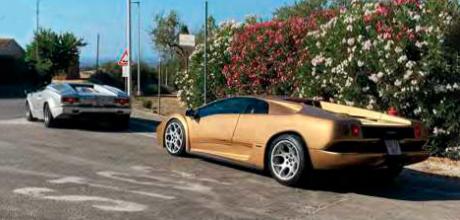1990 Lamborghini Countach 25th Anniversary vs. 2001 Diablo VT 6.0 SE
RAgeing Bulls. Lamborghini has always produced outrageous cars – but what happens when old oxen mature? We drive the very last Countach and Diablo off the line to find out.
Story by Chris Rees
Images by Lamborghini/Pirelli
LAMBORGHINI COUNTACH V DIABLO
Last-of-the-line Lambos limber up
Original is best, goes the saying. But every car (pretty much) gets altered over its lifetime. And according to every car manufacturer (pretty much), the last of the line is always the ultimate, in both senses of that word. Last of the line should be best, but is it really? Well, I’m about to find out behind the wheels of two generations of V12 mid-engined Lamborghini supercars. What we’re looking at here are not only the ultimate incarnations of the Countach and Diablo, but the very last examples of each off the line.
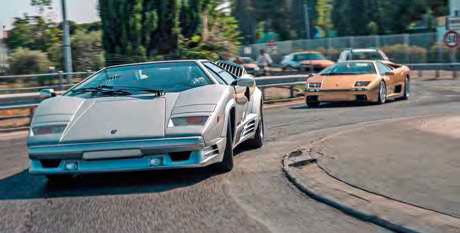
In the case of the Countach, that’s the final chassis of the 25th Anniversary model, a car that had been first revealed at the 1988 Paris Show. Confusingly, perhaps, that was 15 years into the model’s lifespan – the ‘25’ bit celebrated the company's silver anniversary. Some 658 ‘Anniversario’ Countachs were made, making this the most numerous version of a total of 2000 ’Tachs built.
Famously, the Anniversary redesign was the work of a young Horacio Pagani, later to establish his own supercar marque, of course. Controversy has always surrounded this final evolution, whose smoothly integrated rear air inlets adopted strakes that some thought were a straight rip-off of Ferrari’s Testarossa, echoed in air inlets ahead of the front and rear wheels. A body-coloured rear panel housed new taillights, too, although ‘our’ car lacks the huge optional rear spoiler (thankfully in my view).
As for the Diablo, what we have here is a run-out VT 6.0 Special Edition from 2001. Lamborghini planned to make 40 examples, but ended up building 42, of which this is the 42nd. Its gold paintwork and carbon trim certainly make it stand out, and I’m fascinated to find out how it drives.
Now it’s my chance. Both cars normally live at Mudetec, Lamborghini’s spectacular museum at Sant’Agata, but today they have been extracted so that I can have a go on public roads. Separated by 11 years, they represent the ultimate visions of the Raging Bull in the Chrysler-owned era. But which one would I prefer to drive back home – Countach or Diablo?
COMPELLING LAMBORGHINI COUNTACH
Special doesn’t begin to describe this feeling. At Misano circuit near Rimini, I’ve just been given the keys to the very last Countach ever built: a metallic silver car produced on 4 July 1990 and sent straight to Lamborghini’s museum in Sant’Agata, where it has resided ever since. It has just 9000km on the clock. I’m mute and in awe as I open the scissor door, as if a fallen angel is extending one of its wings. And it feels like I could be flying to heaven as I peer inside – or at least, flying into space. If today’s Lambos cockpits resemble the Millennium Falcon, the Countach’s cabin is a slightly clonky, 1980s sci-fi set; something out of Blake’s Seven, perhaps. Far from the shocking neon colour schemes of today’s Huracáns and Aventadors, the ’Tach Anniversary is a surprisingly lacklustre expanse of dull grey leather. Climbing over the big sill, it’s easy to fall into the not-very-bolstered seats, but achieving a comfortable driving position isn’t helped by massively offset pedals and eccentric ergonomics, such as the handbrake hidden in the sills.
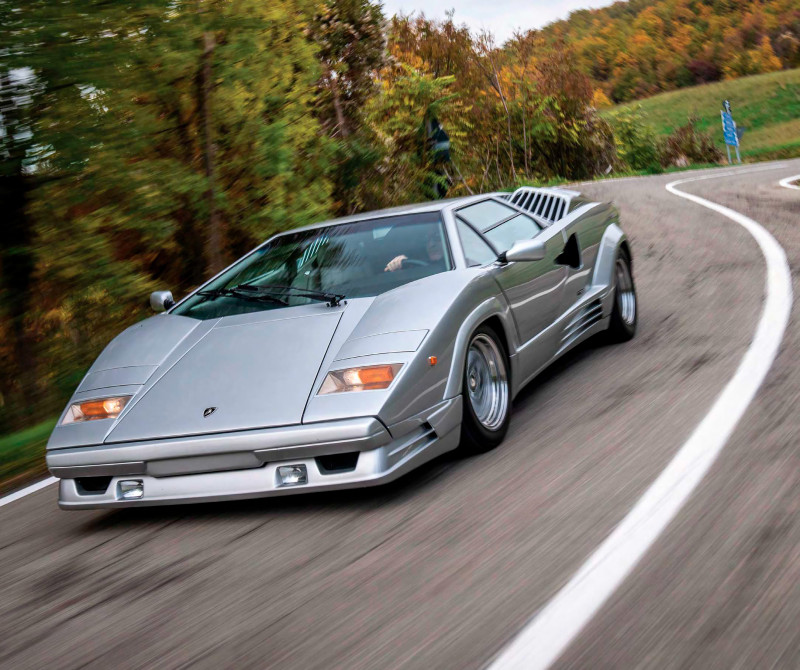
No time to worry about that. The weather in Rimini is on the inferno side of scorchio. There is no functioning air conditioning in this car: it’s time to man up and accept the sweat. The Countach has no problems starting – a real achievement considering it has six double-barrel Weber 44 DCNF carburettors (US versions got Bosch fuel injection).

The symphony of this thing is amazing. Twelve cylinders, four chain-driven camshafts and 48 valves make a promising overture, but they’re quickly upstaged by the starring chorus: Weber sextuplets that suck so hard on the atmosphere that it feels like reality itself is about be swallowed. As the revs rise, the insistent bellow of the exhaust takes over in a rising crescendo, from basso profundo to soaring soprano. Truly, nothing sounds like a Countach. Not much goes like it, either. With 455hp to play with from the 5.2-litre V12, this is a genuinely quick car, even by today’s standards, as long as you keep the revs high. It doesn’t perhaps flatter the Countach that I’m following an Aventador on my route, but the older car certainly doesn’t embarrass itself.
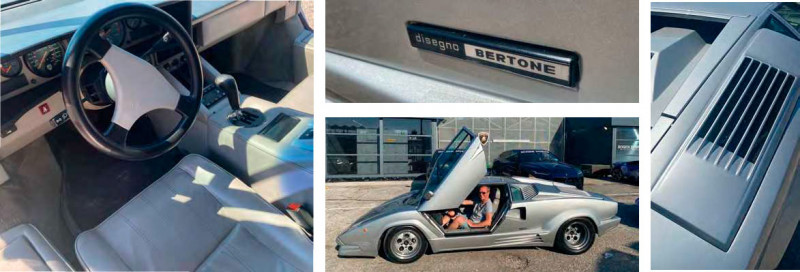
The Countach is not really about raw speed, though: it’s about the many ways in which the experience is memorable – and that includes the multiplicity of challenges you’re faced with. The clutch is a recurring nightmare of heavy treacle; the gearchange is clunkily awkward; the steering is unassisted and not particularly fast-acting (3.15 turns lock-to-lock). The flipside is that everything feels mechanical, direct and honest.
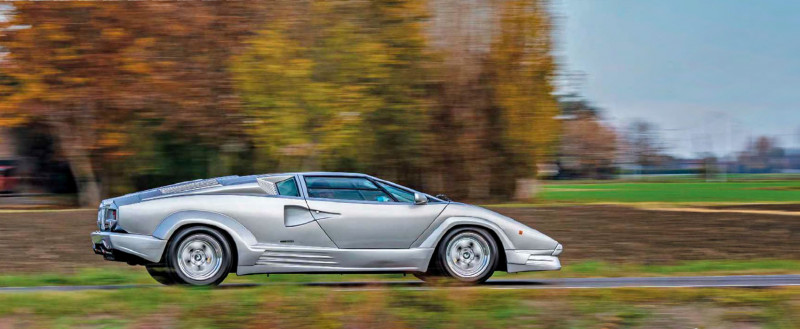
That includes the brakes. I only discover there’s no ABS when I hoof hard for a hairpin and the front end locks up momentarily. The Lambo swerves like a bullock in front of a matador, a wild animal that you can only tame with your own skill. I’m barrelling into the hairpin at a slightly higher speed than I’d have liked, but the Countach reacts predictably to pull me around. As I press the accelerator hard to fire towards the next hairpin – what’s this? – the back end drifts delicately out. It’s delicious and reassuring, in stark contrast with some of the tall tales of unpredictable handling I’ve heard, and the challenges of its 41/59 front/rear weight distribution.
The confident cornering is certainly helped by the Pirelli PZero Asimmetrico tyres wrapping the OZ multi-piece alloy wheels. At launch, these tyres were the widest ever fitted to a production car: 225/50ZR15 front and 345/35ZR15 rear. The Countach was one of the first cars in the world to receive PZeros, although not quite the first (that was the 1986 Lancia Delta S4). This Kevlar-reinforced tyre has an asymmetric pattern and a compound derived from racing experience. That certainly shows in superb feedback about what the nose is doing, while the rear tyres – huge even by today’s standards – offer just the right balance between grip and playfulness.
TECHNICAL SPECIFICATIONS 1990 Lamborghini Countach 25th Anniversary
- ENGINE: 5167cc V12 DOHC 64-valve
- BORE X STROKE: 85.5mm x 75mm
- COMPRESSION RATIO: 9.5:1
- MAX POWER: 455hp at 7000rpm
- MAX TORQUE: 501Nm (370lb ft) at 5200rpm
- TRANSMISSION: ZF 5-speed manual
- SUSPENSION: Double wishbones, coil springs, telescopic dampers (front). Upper lateral link/radius arm, lower wishbone/radius arm, dual coil spring/telescopic dampers (rear). Anti-roll bars all round
- BRAKES: Ventilated discs, four-piston callipers
- TYRES: 225/50 VR15 (fr), 345/35 VR15 (rear)
- DIMENSIONS: 4140mm (L), 2000mm (W), 1070mm (H)
- WEIGHT: 1490kg
- MAX SPEED: 183mph
- 0-62MPH: 5.0sec
Sweat-inducing drive was caused as much by the rawness of the experience as the heatwave conditions
DEVILISH LAMBORGHINI DIABLO
After the brow-moistening Countach experience, it’s time to get cool in its successor: the Diablo. What I have in front of me is, like the ’Tach, the very last off the line – the 42nd of 42 VT 6.0 Special Editions made in 2001. Just two colours were offered for the SE: Oro Elios, a metallic gold that supposedly evokes an early sunrise and Marrone Eklipsis, a metallic maroon-brown that symbolised the opposite – sunset. Not sure I’m a fan of the gold paint of our example, but there’s no denying the impact that Marcello Gandini’s stellar design continues to exert more than three decades on: stubby nose, swooping waistline and a tail that seems to go on forever, with louvres and dams emphasising the extreme wedginess of it all.
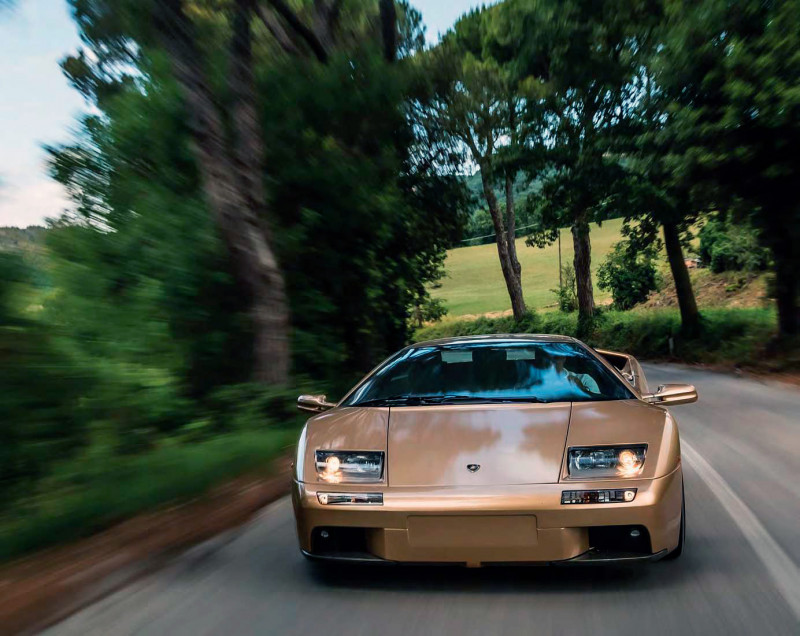
Just like the Countach, you enter the car via scissor doors, but it’s much easier to get in and out. And the sight that greets you inside could hardly be more of a contrast. The electrically adjustable brown leather seats are surprisingly cosseting. The gear lever, surround and instrument bezels – all in titanium – look great, and the Alpine DVD audio/sat nav is oh-so early 2000s. But what you clock most is the symphony of exposed carbonfibre – centre tunnel, main dash, steering wheel boss – all threaded with titanium to give it a glossy lustre. And I’m certainly gratefully that the air conditioning is functioning – phew! – even if the scorching ambient temperature is making the Diablo itself sweat with lambda sensor problems. Thankfully a quick laptop reset sees us on our way.
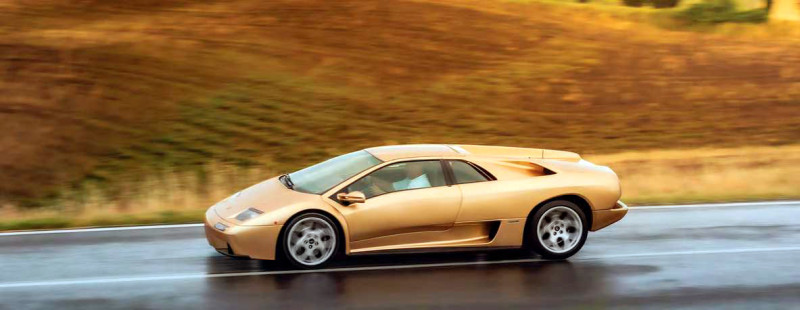
If the Diablo’s name is intimidating – meaning ‘devil’ in Spanish – its sheer size is almost overwhelming. It’s much longer than the Countach and broader at well over two metres wide. Even by today’s bloated standards, it’s a handful to manoeuvre, especially with such limited visibility (I note the museum staff move both cars around by sitting on the sill). But the driving position instantly feels much more comfortable. OK, we’re moving, and initially I sense the family links with the Countach. It’s got basically the same V12 engine, expanded from 5.2 to 6.0 litres. In this final variation, power was taken up to 550hp and torque to 620Nm, so even with an extra 130kg of weight to carry, the Diablo feels a fair bit faster than its forebear – the claimed top speed of 208mph is probably actually achievable. There’s loads of torque at low revs, enabling you to pull away smoothly in fifth gear with just 1200rpm on the clock. The engine sound is a little more muted, though, partly because multi-point fuel injection has replaced carbs.
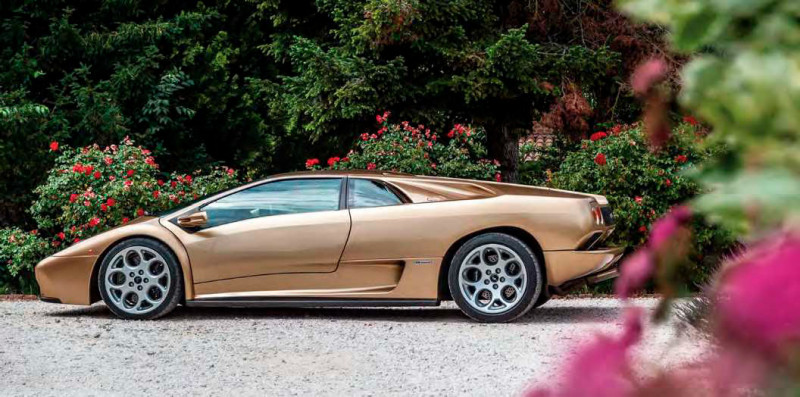
The gearbox is another huge difference. The five-speed unit has a delicious open gate and an action that invites frequent changes. The SE has short-ratio gearing to boost acceleration and there’s always a tidal wave of torque waiting if you keep the revs reasonably high.
The four-stage electronic dampers are adjusted via a little pad to the right of the gear lever but the differences between the settings don’t seem huge, so I leave it in ‘Auto’ mode for the most part.
Incidentally, only Lamborghini would countenance fitting a little light here labelled ‘Error’. The cornering feels ultra-confident, with immense grip available from the generously-sized Pirelli PZero Corsa tyres (245/35 ZR18 front, 335/30 ZR18 rear). There’s some initial understeer but once the car has settled into the corner, the front end bites via the steering. Then you can either unwind the steering wheel gently or have some fun by deploying the full 550hp to loosen the rear end.
Like the Countach, everything feels analogue, while some traditional Lambo quirks remain – heavy accelerator pedal, for instance – but overall the Diablo feels like a car from a different era to drive. The steering is much easier; it’s surprisingly docile at low speeds; you don’t have to be so brutal with the controls; and the ride is much more comfortable. In fact, the Diablo 6.0 SE is almost – almost – easy to drive.
Then it strikes me. To drive, the Diablo feels like a bigger, badder version of my own Alfa Romeo SZ. The steering feel is remarkably similar, despite the divergence in engine positioning; the engine sounds like a Busso V6 multiplied by two; and the hunkered-down feel around corners is even quite similar. No bad thing in my book.
TECHNICAL SPECIFICATIONS 2001 Lamborghini Diablo VT 6.0 SE
- ENGINE: 5992cc V12 DOHC 64-valve
- BORE X STROKE: 87mm x 84mm
- COMPRESSION RATIO: 10.7:1
- MAX POWER: 550hp at 7100rpm
- MAX TORQUE: 620Nm (457lb ft) at 5500rpm
- TRANSMISSION: ZF 5-speed manual
- SUSPENSION: Double unequal-length wishbones, coil springs, electronic dampers, anti-roll bars
- BRAKES: Ventilated/perforated discs, four-piston callipers
- TYRES: 245/35 ZR18 (fr), 335/30 ZR18 (rear)
- DIMENSIONS: 4460mm (L), 2040mm (W), 1105mm (H)
- WEIGHT: 1625kg
- MAX SPEED: 208mph
- 0-62MPH: 3.95sec
Diablo is much easier to drive than Countach but still a big experience – literally, with immense girth.
VERDICT
Both of these Lamborghinis come from an era when cars like this were called “real men’s motors”. Most modern supercars are easy to drive fast, and in safety. In contrast, these ageing, raging bulls can be a real challenge to drive, but both deliver an utterly memorable experience.
No question, the Diablo trumps the Countach’s rudimentary stabs at sophistication. If the devil is in the details, the Diablo’s keener grasp of what makes a car tick mean it’s far easier to live with. It has a superior interior and ergonomics, a more comfortable ride, better straight-line pace and is easier to drive both at low speeds and on the limit. Pretty much everything works much better, with most of the Countach’s flaws neatly ironed out.
So why is it that I come away with much stronger feelings for the ’Tach? The cabin is awful yet lovable in the way you might remember 1970s sit-coms with fondness. Its sonorous, carb-fed V12 and hefty clutch/gearchange combo feel more primal. The extra effort you have to put into driving is rewarded tenfold by the raw, unadulterated pleasure of every corner, every straight, and even when you’ve parked up and crowds are thronging around it.
In short, the Countach is a barely tamed animal. It’s not house-trained. It will bite you at some point, however much you think you know it. For these reasons – the very fact that it’s dangerous and exciting – it’s the car that stirs emotions with the bigger spoon, a spoon that’s probably laced with MDMA. If you’re looking for a car to make you feel truly alive, possibly before it kills you, here it is.
PIRELLI AT 150
My driving opportunities in Rimini were furnished by Pirelli as a very agreeable way to celebrate its 150th anniversary. After all, Pirelli tyres have been original equipment fitment for every single Lamborghini from the very start in 1963. Things kicked off with a visit to Pirelli in Milan and a fascinating tour around the headquarters, which develops Formula 1 tyres alongside road tyres. F1 was Pirelli’s province from the start, of course, fitted to five of the first seven F1 world championship winners in the 1950s. This year has seen the biggest revolution in F1 tyres for generations: having used 13-inch tyres since the 1960s, the adoption of 18-inch tyres in Formula 1 arrived in 2022 following more than two years of research, development and testing. Pirelli points out that the transfer of race technology to the road is more pertinent as a result, since most road cars these days have very big wheels. Pirelli has 50% of the prestige market in sizes bigger than 18 inches. Pirelli’s virtual development programme is extremely impressive, and explains how F1 tyres can be homologated before the cars they’ll be fitted to even exist. It’s a similar story with road car tyres, in fact: the design and experimentation happens first in virtual reality, hand-in-hand with the car manufacturers, based on technical data they supply, to perfect the best tyre for each model even before the first physical prototype is built in real life.
A very pertinent way to appreciate Pirelli’s long history was seeing its Collezione range of vintage tyres, now available for classic cars. Pirelli spends a lot of time recreating the original drive feel and style but uses updated materials and manufacturing processes to offer the best possible safety and reliability. For instance, you can now buy brand new Stella Bianca tyres, first seen in 1927. This tread remained almost identical until the 1950s and was used in Formula 1 with Alfa Romeo, Ferrari and Maserati, as well as road cars like the Alfa Romeo 1900, Ferrari 250 GT and Maserati A6.
The iconic Cinturato tyre of the 1950s and 1960s introduced textile belts into tyres, greatly improving tyre deformation. And the Lamborghini Countach was one of the early cars to receive the PZero of the 1980s. This tyre has been developed over many decades and is still in production in highly developed form. As my test of both Countach and Diablo prove, PZeros were way ahead of their time, not only in terms of sheer size – the Countach 25th Anniversary had the widest tyres of any car ever at launch – but also performance.
“I only discover there’s no ABS when I hoof hard for a hairpin and the Lambo swerves like a bullock in front of a matador ”


